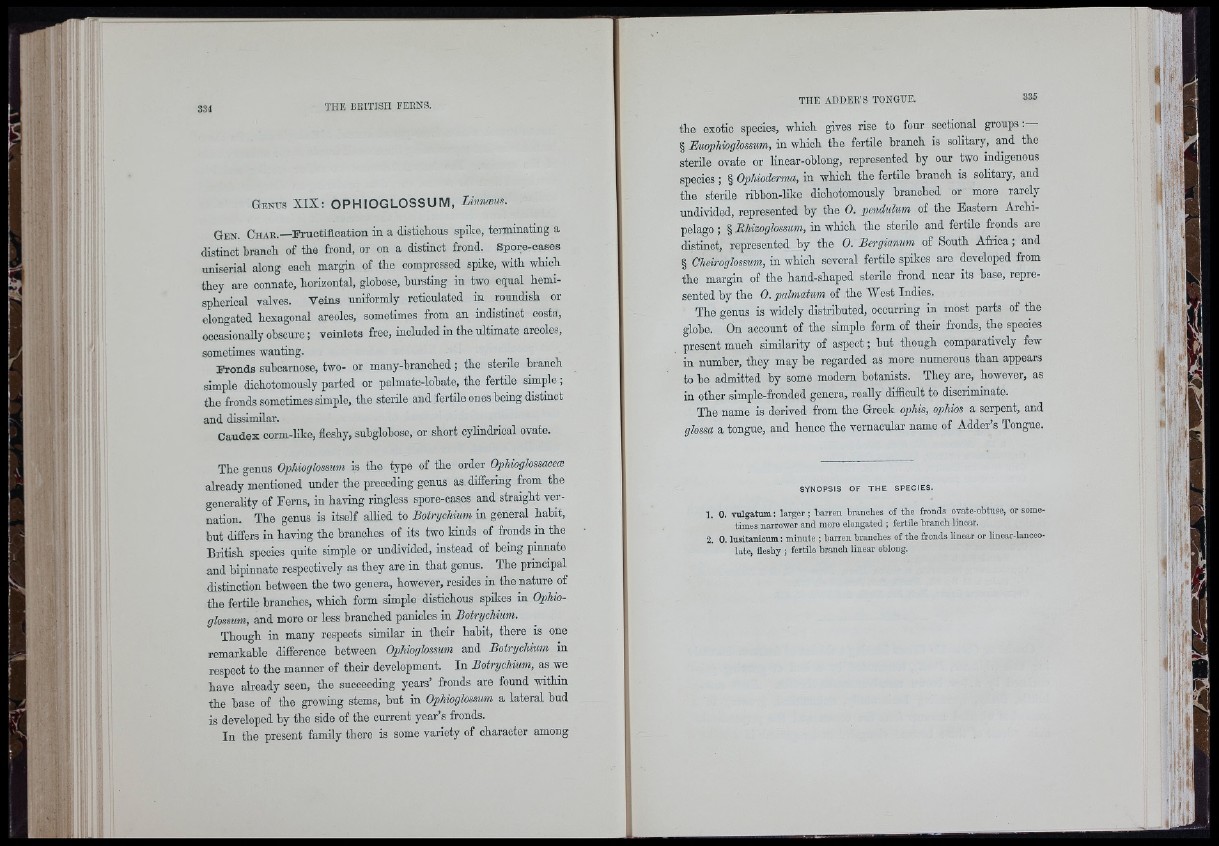
' tSb ' ■
THE BEITISH FEENS.
G e n u s XIX: O P H I O G L O S S U M , Linnaius.
Gen. C h a r .— Fructifloation in a disticlious spike, terminating a
distinot branoh of tbe frond, or on a distinct frond. Spore-oases
uniserial along each margin of the compressed spike, with which
they are connate, horizontal, globose, hui-sting in two equal hemispherical
valves. Veins uniformly reticulated in roundish or
elongated hexagonal areoles, sometimes from an indistinct costa,
occasionaUy obscure; v einlets free, included in the ultimate areoles,
sometimes wanting.
Fronds subcarnose, two- or many-branohed ; the sterile branch
simple diohotomously parted or palmate-lohate, tho fertile simple ,
the fronds sometimes simple, tho sterile and fertile ones being distinct
and dissimilar.
Caudex corm-Uke, fleshy, subglobose, or short cylindrical ovate.
The genus Ophwglossimi is the type of the order Ophioghssacem
already mentioned under the preceding genus as differing from the
generality of Ferns, in having ringless spore-cases and straight vernation.
The genus is itself allied to Botrychium in general habit,
but differs in having the branches of its two kinds of fronds in tho
British species quite simple or undivided, instead of being pinnate
and bipinnate respectively as they are in that genus. The principal
distinction between the two genera, however, resides in the nature of
the fertile branches, which form simple distichous spikes iu Ophioglossum,
and more or less branched panicles in Botrychium.
Though in many respects similar in their habit, there is one
remarkable difference between Ophioglossum and Botrychium in
respect to the manner of their development. In Botrychium, as we
have already seen, the succeeding years’ fronds are found within
the base of the growing stems, but in Ophioglossum a lateral bud
is developed by the side of the current year’s fronds.
In the present family there is some variety of character among
the exotic species, which gives rise to four sectional groups:—
§ Euophioghssum, in which the fertile branch is solitary, and tho
sterile ovate or linear-ohlong, represented by our two indigenous
species; § Ophioderma, in which the fertile branch is solitary, and
the sterile rihbon-like diohotomously branched or more rarely
undivided, represented hy the 0. pendulum of the Eastern Archipelago
; § Rhizoglossum, in which the sterile and fertile fronds are
distinot, represented by the 0. Bergianum of South Africa; and
§ Cheiroglossum, in which several fertile spikes are developed from
the margin of the hand-shaped sterile frond near its base, represented
by the 0. palmatum of the West Indies.
The genus is widely distributed, ooourring in most parts of the
globe. On aooount of the simple form of their fronds, the species
present much similarity of aspect; hut though comparatively few
in number, they may he regarded as more numerous than appears
to be admitted hy some modern botanists. They are, however, as
in other simple-fronded genera, reaUy difficult to discriminate.
The name is derived from the Greek ophis, ophios a serpent, and
glossa a tongue, and henco the vornaoular name of Adder’s Tongue.
'll rir.l
!1
SYNOPSIS OF TH E SPECIES.
1. 0. v u lg a tum ; la rg e r; Larren branches of tb e fronds ovate-obtuse, or sometimes
narrower and more elongated ; fertile branch linear.
2. 0. lusitanicum: minute ; barren branches of th e fronds linear or linear-lanceolate,
fleshy ; fertile branch lin ear oblong.
y-'.. -
■5, . '
I p
iff